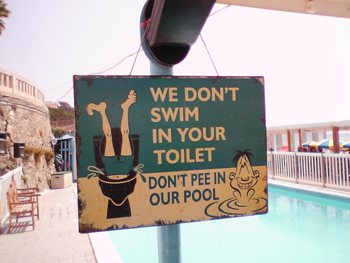Science News for Students Scientist Know You Pee in the Pool
We know you would never practise it. Merely some people pee in swimming pools and hot tubs. This isn't just a gross addiction. When chlorine reacts with urine, it creates chemicals that can irritate optics and lungs. Now researchers can mensurate this disgusting behavior. They've found a simple way to judge the volume of urine in a pool.
The technique could aid people decide when to change some or all of the h2o in a puddle or hot tub, the researchers say. Merely the new research isn't really meant to create new rules for pool managers. It'south supposed to emphasize a bulletin: Don't pee in the puddle!
Past itself, urine in pools isn't a problem. That'due south because a healthy person's pee is typically sterile, or germ-gratuitous, says Lindsay Blackstock. She's an analytical chemist at the Academy of Alberta in Edmonton, Canada. Merely puddle water too contains chlorine, a chemical that kills germs. Trouble can ascend when that chlorine reacts with urine. It can trigger the production of dozens of new byproducts. Many of these new chemicals volition cause no harm. Just some, especially one called trichloramine (Effort-KLOR-ah-meen), are known irritants.

Fifty-fifty if yous've never heard of trichloramine, you've probably smelled information technology. That distinct "swimming pool scent" at most pools doesn't come from the chlorine, notes Blackstock. Information technology's trichloramine. Information technology can sting the eyes. The pungent chemical likewise tin irritate the lungs.
Equally pee in a pool increases, the amounts of trichloramine will besides. The more than trichloramine there is, the more irritating it can be to swimmers. So Blackstock and her teammates wanted to encounter if they could estimate how much urine was present in pool h2o. There'south no simple manner to test for urine straight. (Take y'all ever heard that puddle water has a chemic in information technology that will alter colour if you pee? That'southward merely a myth.)
And so the researchers needed a marker for the urine — another substance that would signal the likely presence of pee. And that's what acquired them to focus on acesulfame (Donkey-eh-sul-faym) potassium. It'southward an artificial sweetener used in foods and drinks. It's sold under the make names Sunett and Sweet One. The chemical is also called Ace-One thousand for short.
It makes a good marker for pee, says Blackstock. For i, it has no natural sources and is very stable. It doesn't break down at normal temperatures, which is why many nutrient manufacturers apply Ace-K. Even after beingness stored in foods at room temperature for 10 years, it won't take broken down. It also won't pause down in pools or exist removed during h2o-cleanup treatments.
Moreover, Ace-K passes right through the human torso without being digested. That makes information technology a great choice as a low-calorie sweetener (the body doesn't go any energy from information technology). Merely information technology likewise fabricated Ace-K a good choice for their study, says Blackstock. The substance doesn't go out the trunk in sweat, jiff or poop. Ace-G merely leaves the body in urine. And when it comes out, it volition exist the aforementioned grade of the chemical as had been ingested.
Foul findings
First, the researchers needed to know how much Ace-Thou is nowadays in the average person's urine. They collected urine samples from twenty people and mixed them together. Each milliliter of urine (about i-fifth of a teaspoon) contained about 2.36 micrograms of Ace-Grand.
Then, on fifteen days in August 2016, the team collected water samples from two swimming pools in a metropolis in Canada. One puddle held well-nigh 420,000 liters (110,000 gallons). The other had about twice that volume. On the aforementioned days, the researchers also collected iii samples from the city'south water supply.
Liter-sized samples of the urban center's tap water contained between 12 and xx nanograms of Ace-K. (Remember, Ace-K doesn't decompose during water treatment.) If there were no pee in the pools, they should accept had like levels of Ace-K. The smaller pool, though, had 156 nanograms of Ace-K per liter of water. And the larger pool had fifty-fifty more than, about 210 nanograms per liter. That adds upwards to most 30 liters (almost 8 gallons) of urine in the pocket-sized puddle. The larger pool held a whopping 75 liters (nearly 20 gallons) of pee!
These pools probably aren't unusual, says Blackstock. In 2014, the same researchers found Ace-Yard in unusually high concentrations in 21 public pond pools, 8 hot tubs and even a private swimming puddle. In other words, every pool and hot tub they tested had pee in it. Blackstock and her squad shared their new findings online March 1 in Ecology Science & Applied science Letters.
The team's approach "is a pretty cool idea," says Beate Escher. She'due south a toxicologist at the Helmholtz Center for Ecology Research in Leipzig, Frg. Researchers have used Ace-K earlier to measure h2o pollution, she says, both on and merely beneath Earth'due south surface. And Ace-1000 holds some advantages over other substances, such equally caffeine, that researchers have used as a mark of urine. Caffeine, for case, can break downwardly later on information technology leaves the body. "Ace-G is much more than stable," Escher says.
Like Blackstock and her team, Escher suggests the all-time style to tackle urine is pools is prevention, non clean-up. Then delight, she urges, don't pee in the puddle: "Self-control is the all-time matter."
Source: https://www.sciencenewsforstudents.org/article/scientists-know-you-pee-pool

Postar um comentário for "Science News for Students Scientist Know You Pee in the Pool"